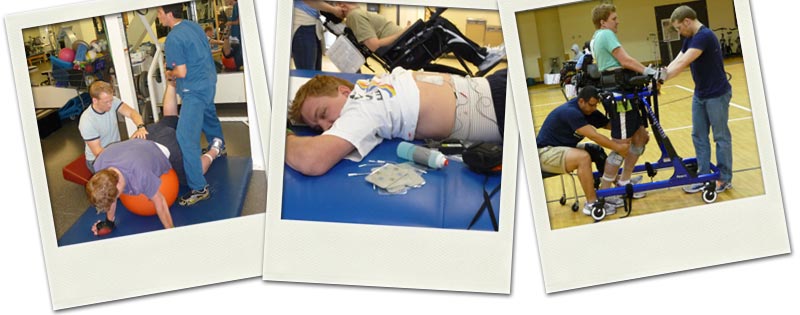
Spinal Injuries
Spinal cord injury (SCI) involves damage to the nerves within the bony protection of the spinal cord that results from cord injury trauma caused by disease or accidents. The spinal cord does not have to be severed in order for a loss of function to occur. It is very common for the spinal cord to be intact but bruised and in shock. An injury cord looses the ability to send and receive messages from the brain to the body’s systems that control sensory, motor and autonomic function below the level of the injury often resulting in paralysis.
Spinal cord trauma is more than a single event. The initial blunt force damages or kills spinal nerve cells. In the hours and days after the injury a cascade of secondary events, including the loss of oxygen and the release of toxic chemicals at the site of the injury, further damage the cord.
Acute care may involve surgery if the spinal cord appears to be compressed by bone, a herniated disk or a blood clot. Presently surgeons are advocating immediate, early surgery.
Generally speaking, after the swelling of the spinal cord begins to go down, most people show some functional improvement after an injury. Many, especially those with incomplete injuries, recover function 18 months or more after the injury. Some regain some function years after the injury.
Nerve cells (neurons) of the peripheral nervous system (PNS), which carry signals to the limbs, torso and other parts of the body, are able to repair themselves after injury. Nerves in the brain and spinal cord, within the central nervous sytem (CNS), are not able to regenerate.
The spinal cord includes nerve cells (neurons) and long nerve fibres (axons) that are covered in myelin, a type of insulating substance. Loss of myelin, which can occur with cord trauma, prevents effective transmission of nerve signals. Nerve cells of the brain and spinal cord respond to trauma and damage differently to most other cells of the body. They are confined within bony cavities to protect them, but this leaves them vulnerable to compression damage caused by swelling or forceful injury.
Spinal cord injuries are most commonly caused by motor vehicle accidents, followed by sports-related injuries, falls and acts of violence. People who sustain spinal cord injuries are mostly in their teens or twenties, although as the population in general ages, the percentage of older persons with paralysis is increasing. About four out of five people with spinal cord injuries are male. More than half of spinal cord injuries occur in the cervical area, a third in the thoracic are and the remainder mostly in the lumbar region.
Complete vs Incomplete Injury
Those with an incomplete injury have some spared sensory or motor function below the level of the injury as the spinal cord was not totally damaged or disrupted. In a complete injury, nerve damage obstructs all signals coming from the brain to the body below the injury.
People with incomplete injuries have a better chance of getting more functions to return. The sooner muscles start working again, the better the chances are of recovery. The longer there is no improvement, the lower the odds.
The Spinal Segments and Lost Functions
The spinal cord is organised into segments along its length, noted by their position along the 33 vertebrae of the backbone, with each segment responsible for motor or sensory functions for specific areas of the body. In general, the higher in the spinal column an injury occurs, the more function a person will loose.
Cervical Region
The segments in the neck (cervical) region – C1 to C8 – control signals to the neck, arms, hands and, in some cases, the diaphragm. Injuries in this area result in tetraplegia, or as it is more commonly called, quadriplegia.
Injuries above C3 may require a ventilator.
Injuries above C4 usually mean loss of movement and sensation in all four limbs. Often shoulder and neck movement is available to facilitate sip-and-puff devices for mobility, environmental control and communication.
C5 injuries often spare the control of shoulder and biceps, but there isn’t much control at the wrist or hand. Those at C5 can usually feed themselves and independently handle many activities of daily life.
C6 injuries generally allow wrist control permitting them to drive adaptive vehicles and handle personal hygiene, but they often lack fine hand function.
Those with C7 and T1 injuries can straighten their arms and can typically handle most self-care activities but may still have dexterity problems with hands and fingers.
Thoracic Region
Nerves in the thoracic (upper back) region – T1 to T12 – relay signals to the torso and some parts of the arms. T1 to T8 injuries usually affect control of the upper torso, limiting trunk movement due to a lack of abdominal muscle control, unlike T9 to T12 injuries that allow good trunk control and good abdominal muscle control.
Lumbar Region
Those injured in the lumbar, or mid-back region just below the ribs – L1 to L5 – are able to control signals to the hips and legs. A person with an L4 injury can often extend their knees.
Sacral Region
The sacral segments – S1 to S5 – lie just below the lumbar segments and control signals to the groin, toes and some parts of the legs.
Secondary Issues
Besides a loss of sensation or motor function, injury to the spinal cord leads to other changes including:
- Loss of bowel, bladder and sexual function
- Low blood pressure
- Autonomic dysreflexia (for injuries above T6)
- Deep vein thrombosis
- Spasticity
- Chronic pain
- Pressure ulcers
- Respiratory complications
- Urinary tract infections
- Pain
- Obesity
- Depression
However, they are mainly preventable with good healthcare, diet and physical activity.
This has been written with the assistance of the Paralysis Resource Guide. This guide is published by the Christopher and Dana Reeve Foundation’s Paralysis Resource Center. Find out more about the Guide here and the Foundation here.
